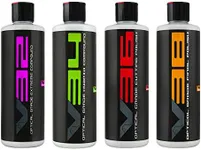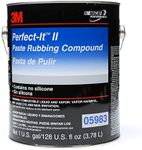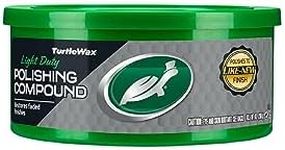Buying Guide for the Best Car Rubbing Compounds
Choosing the right car rubbing compound is important for maintaining your vehicle’s paint and keeping it looking its best. Rubbing compounds are used to remove scratches, oxidation, and other imperfections from your car’s surface. The right product can restore shine and smoothness, but picking the wrong one can damage your paint or not deliver the results you want. To make a good choice, you need to understand the key features and how they relate to your car’s condition and your goals.Abrasiveness (Grit Level)Abrasiveness refers to how coarse or fine the rubbing compound is. This is important because a more abrasive compound removes deeper scratches and heavier oxidation, but it can also remove more of your car’s clear coat. Compounds range from heavy-cut (very abrasive) to fine-cut (less abrasive). Heavy-cut is best for severe paint defects, while fine-cut is for light scratches or finishing. To pick the right one, assess your car��’s paint: if you have deep scratches or heavy oxidation, start with a more abrasive compound, but for minor imperfections or regular maintenance, a fine or medium compound is safer and easier to use.
Type (Paste, Liquid, or Cream)Rubbing compounds come in different forms: paste, liquid, or cream. Paste compounds are thicker and often more abrasive, making them suitable for tough jobs, but they can be harder to apply and remove. Liquid and cream compounds are easier to spread and buff, making them better for beginners or for lighter work. If you’re new to car care or just need to fix small imperfections, a liquid or cream compound is usually the best choice. For more serious paint correction, a paste might be necessary, but it requires more care and effort.
Application MethodSome rubbing compounds are designed for hand application, while others work best with a machine polisher. Hand application is gentler and gives you more control, making it suitable for small areas or light work. Machine application is faster and more effective for large areas or deeper defects, but it requires some skill to avoid damaging the paint. Think about your experience level and the size of the job: for small touch-ups or if you’re a beginner, hand application is safer. For larger jobs or if you have experience with polishers, a machine-compatible compound can save time and effort.
Paint CompatibilityNot all rubbing compounds are safe for every type of paint. Some are formulated for modern clear coats, while others may be suitable for older single-stage paints. Using the wrong type can cause damage or poor results. Always check if the compound is compatible with your car’s paint type. If you’re unsure, look for products labeled as safe for all finishes, or consult your car’s manual or a professional.
Ease of Use and CleanupSome compounds are easier to work with than others. Ease of use includes how easily the product spreads, how much effort is needed to buff it off, and whether it leaves residue. Compounds that are easy to apply and remove save time and reduce the risk of mistakes. If you’re new to using rubbing compounds or want a quick job, look for products that advertise easy application and cleanup. More advanced users might be willing to work with tougher products for better results, but for most people, convenience is a big plus.



















